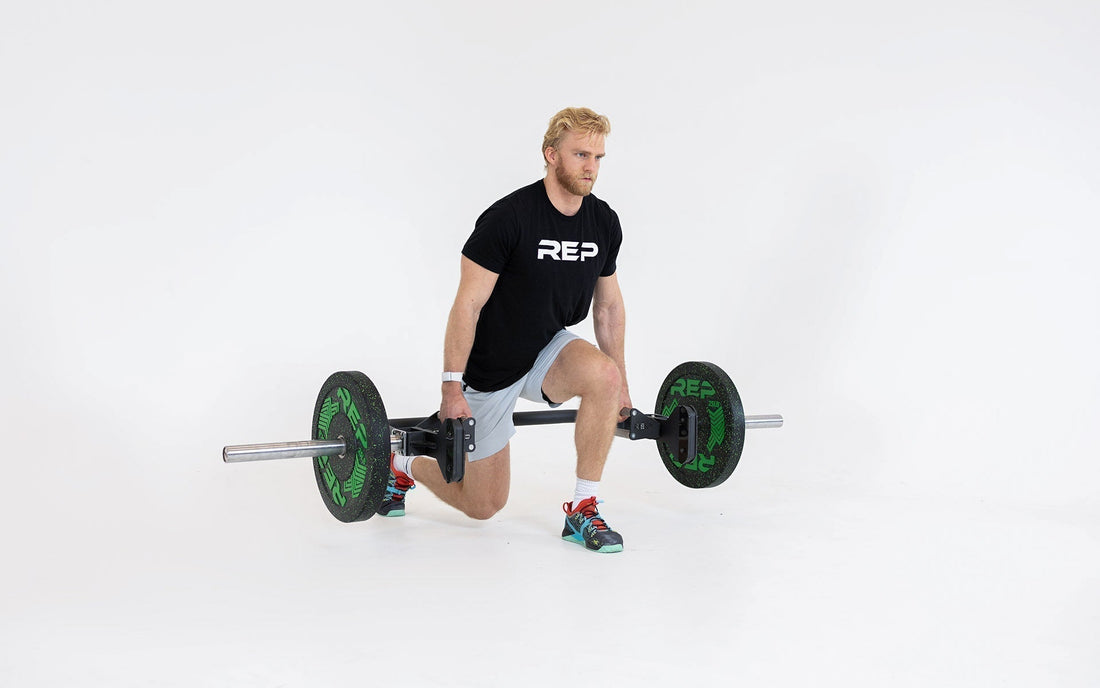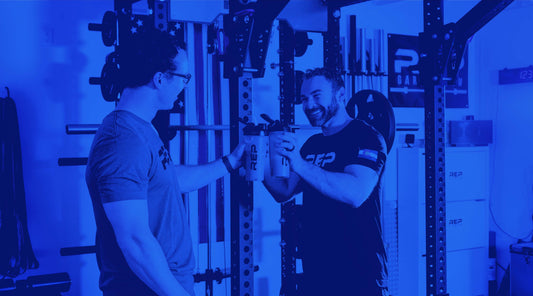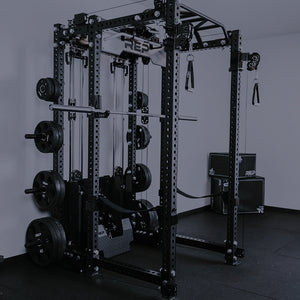
Let's do the splits.
Hip thrusts and deadlifts get all the hype when it comes to lower body day, but hear me out: The split squat is the holy trinity of glutes, quads, and hammies.
So, what is a split squat? Think of it as a stationary lunge where your front leg does most of the heavy lifting and your back leg keeps you steady. As a unilateral lift, it targets each leg individually, helping you tackle muscle imbalances while improving balance. It’s also a smart steppingstone toward mastering more advanced moves like walking lunges or the Bulgarian split squat. Adding split squat exercises into your routine (and utilizing progressive overload), can improve strength, muscle symmetry, stability, and hypertrophy — especially in the glutes and the quads. Now, let’s break down how to do proper split squats, so you can build your backside without falling on it.
How to Do Split Squats with Perfect Form
One of the best things about the split squat is its versatility — you can load it with just about anything. Beginners can start with bodyweight, while more advanced lifters might opt for dumbbells, a barbell, kettlebells, a Smith machine, or even an open trap bar.
For simplicity’s sake, we're reviewing split squat form with dumbbells.
- Place your dumbbells on the floor on either side of you. Drop one knee down to the ground creating two 90-degree angles with your legs.
- With your chest proud, shoulders back, and core braced, grab those DBs.
- Press through the floor with your front foot keeping your entire foot grounded (no raised heels or toes). Your back foot is there for balance: Keep the toes and the balls of your feet touching the ground with your back heel elevated to allow the knee to move away from the ground. Your body should move upward in a straight line. If you're shifting forward, reset and keep your knee from tracking over your toes.
- Now reverse it, lowering your back knee back down, hovering just before it touches the floor.
- Finish your reps on one side before switching legs.
Pro tip: You can control how much glute vs. quad activation you get during this exercise by adjusting your posture. The more upright your shoulders are (think, shoulders pointing towards the ceiling), the more your quads will activate. To target the glutes, lean slightly forward (shoulders pointing toward the top of the wall across from you).
Lastly, if you’re going heavy, dumbbells might not be your best bet for a split squat workout — they can be awkward to hold and limit how much you can lift. Here are some other loading options to consider:
Pros: Easy to progressively load, grip strength won’t be a limiting factor, and increased safety and stability.
Cons: Reduced stabilizer muscle activation due to the fixed bar path (but you can always tack on other exercises for strong abs at the end of your workout).
Pros: Great for loading heavy, grip strength won’t be a limiting factor, and it challenges your balance and coordination.
Cons: Working with a loaded barbell, especially if you’re going heavy, can make balance difficult and place stress on your spine if wobbling or not positioned correctly.
Pros: Easier on the lower back than a barbell, adds stability, and simpler to lift off the ground than dbs.
Cons: Not every gym has one, may limit range of motion, and grip strength may be a limiting factor.
Pros: Handles and padding place less stress on your upper body than a barbell, grip strength won’t be a limiting factor, and you can take a hand away from the bar for balance.
Cons: Not every gym has one.
Split Squats: Muscles Worked and Benefits
Split squats are a variation of a standard squat. However, compared to typical squats, they’re more challenging because you’re working one leg at a time. Split squats target the following muscles:
- glutes
- quads
- adductors (inner thighs)
- core
- erector spinae (back muscles that run along the length of your spine)
As previously mentioned, depending on your torso and shin positioning, you can tweak the movement to emphasize different muscles. A slight forward lean with a more vertical shin will recruit more of your glutes, while an upright torso combined with either a vertical or forward leaning shin places more focus on the quads.
Split squats also improve balance, coordination, and unilateral strength — making them a handy tool for treating muscle imbalances, improving performance, and reducing injury risk. Plus, the range of motion required at the hips and knees can also benefit your mobility and flexibility.
Split Squat Variations and Modifications
Reverse lunge
The reverse lunge allows you to control your balance better than a forward lunge, which makes this an ideal move to help you build up strength for split squats. It also places less stress on your knees while still targeting your quads, glutes, and hamstrings.

Isometric split squat
Isometric training can strengthen muscles and increase stability while limiting joint pain and fatigue. It also may be ideal programming for those with hypertension. In your split squat stance, lower your back knee down so it hovers above the floor. Now, hold this position then repeat on the other side. Aim for 30 seconds on each side, and increase the time as you get stronger.
Front foot elevated split squat
The name of the game here is greater range of motion, which puts an added emphasis on your quads and helps improve mobility. Place your front foot on a riser or a weight plate — maybe a library book if you’re a delinquent, what have you — and extend your back leg behind you. In that elevated stance, your front knee will track further over your toes as you lower down, which increases quad activation. Your glutes then kick in to extend the hip as you drive through your front foot back to standing.

Rear foot elevated split squat (aka Bulgarian split squat)
Also known as a RFE, Bulgarian squat, Bulgarian split squat, or what you’ll often hear muttered: “Why God, why?” Start out by standing a few feet from a bench before extending one leg backwards so the top of your foot rests on the bench. Once you’re steady, lower straight down until your front thigh is parallel to the ground. Then, drive through your front heel to come back to standing tall.

Split squat jump
This explosive variation uses the same movement pattern as a traditional split squat, but adds a spicy jump to dial up the intensity with plyometric power. From your split stance, lower down with control, then drive through your front heel and explode upward. Land softly with bent knees, then sink down and into your next rep.
ATG split squat
Start in your typical split squat position, but as you lower down, send your front knee forward allowing that front heel to lift off the ground. Your front knee will travel over your toes and your glute will sink down towards that lifted heel. ATG, after all, stands for “Ass To Grass.” Fun, right?
Common Mistakes
Split squats may look simple enough, but there are a few common form flops that can trip you up.
Knee Valgus (aka letting your front knee fall inward): Just like with a squat, you want to keep your knee tracking slightly outward during a split squat to protect it from unnecessary stress or a potential ACL injury *dun dun dun*. While the reason for knee valgus can vary, if you find your knee caving in often, consider adding some extra credit prehab work to strengthen your glutes — such as glute bridges, single-leg bridges, and hip thrusts.
Train tracks, not tight ropes: Take up a little space, alright? If you set your feet up in your split squat stance and the side-to-side distance between legs is too narrow, you’re setting yourself up for failure with an unstable base. Think hip-width apart so you’re more balanced throughout the move.
Forward lean and front leg focus: While we’re all about equality her at REP, that’s not the game we’re playing with split squats. Both legs should not be working equally. Don’t lean back so that your weight gets distributed equally on both legs. Instead, lean slightly forward so that the front leg is the primary lifter with your back leg only assisting.
It may look like a lunge, but it’s not a lunge: If you’re scratching your head, wondering “what’s the difference between a split squat vs lunge?” you’re not alone. While they look similar, in a split squat you’re not stepping forward or backward. You’re staying in place and moving straight up and down.
Knee slam: Yeah. Just don’t do that. Ouchie. Your knee shouldn’t even touch the ground during your reps. It should hover slightly off the floor in that deep lunge.
Try It: How to Program Split Squats in Your Workouts
Adding split squats to your routine is simple. Perform 3-6 sets of 4-7 reps per leg roughly twice a week. Remember if your goal is muscle gains, or hypertrophy, you want to train within 1 rep of failure (aka that last rep in your set requires 90-95% effort). If your goal is strength, aim for a challenging weight that doens't bring you too close to failure (e.g. you feel like you have 1-2 more reps in the chamber by the end of your set).
Takeaway
In the words of some low brow philosopher — whose name I can’t quite recall — “Just Do It.” Now that you’re armed with everything you need to know to perform split squats like a pro, it’s time to add them into your leg day routine. Remember to properly warm up, nail the movement pattern, and then use progressive overload to build strength, power, and muscle in your glutes, quads, and hammies.
FAQs
What’s the difference between a split squat and a single-leg squat?
A split squat maintains two points of contact on the floor, one leg out front and the other behind — basically a stationary lunge. On the other hand, a single-leg squat, often called a pistol squat, uses one point of contact and is a more advanced movement requiring a greater demand on stability and mobility. In the pistol squat, the user balances on one leg as they squat down and come back to standing. Throughout the movement, their other leg remains lifted off the floor.
What are split squats good for?
Split squats are a killer move to increase lower-body strength and/or size in your quads, glutes, and hamstrings. Working one leg at a time allows you the ability to identifying and address muscle imbalances, and thanks to the deep stretch at the bottom range of motion, you’ll support mobility in your hips and knees.
Are split squats and lunges the same?
Split squats and lunges are like eyebrows. They’re similar… but different. A split squat maintains a stationary position, with both feet planted in place. A lunge, on the other hand, adds movement with either a forward or backwards step.
Rosie Borchert is NASM-CPT, former Nike Volleyball coach, and fitness writer whose work has appeared on BarBend and Tonal. If anyone would like to hire her to play beach volleyball, snowboard, binge watch TV, or go climbing, please get in touch.
This article was reviewed by Noah Tenenbaum, MS, CSCS, and Thomas Rush, MS, CSCS, USAW L1 for accuracy.

NEWSLETTER SIGNUP
Product launch information, promotions, blogs, and REP news.







